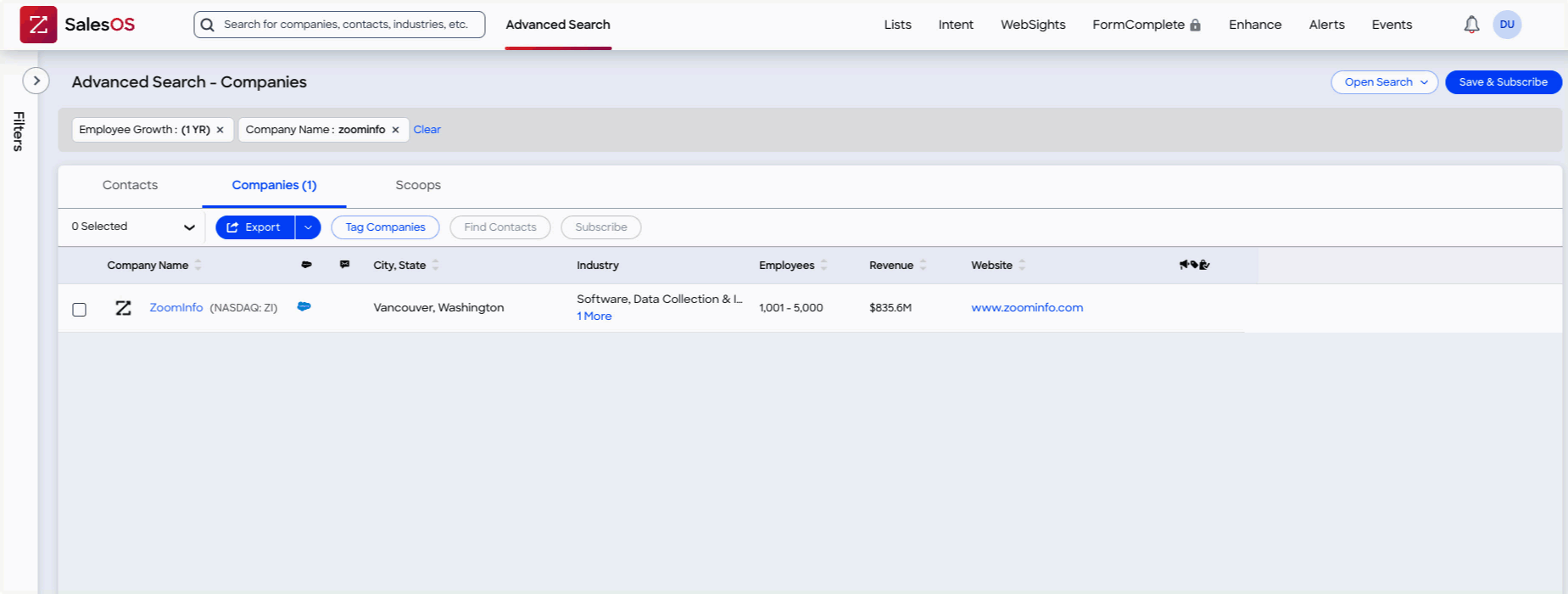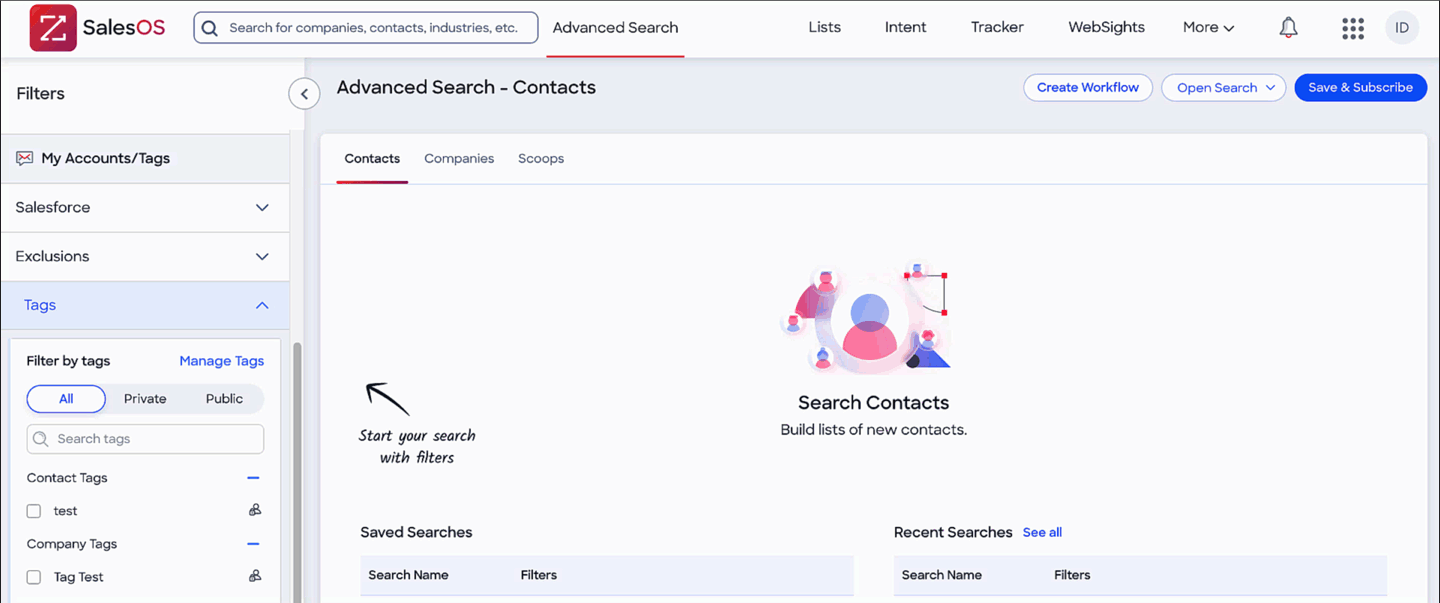The G2 + ZoomInfo integration enables you to view and filter G2 Buyer Intent data directly in ZoomInfo, helping to refine your segmentation, account-based marketing campaigns, and lead qualification.

Basics of the G2 + ZoomInfo integration
About G2 Buyer Intent data
G2 Buyer Intent captures enriched data about buyers researching your product across G2. Buyer Intent signals can be generated by a variety of buyer actions, including interacting with your G2 product profile page, comparing your product to a competitor, and viewing alternatives for a product in a shared category. This data enables your sales, marketing, and customer success teams to identify a buyer's stage in the buyer journey.
Refer to the Buyer Intent documentation for more information on signal types, checking the signals included in your subscription, and more.
How G2 Buyer Intent data is mapped to ZoomInfo
Buyer Intent signals are automatically mapped (auto-mapped) to existing accounts in ZoomInfo’s database by matching the website domain on the Buyer Intent signal to a ZoomInfo account with the same domain.
If the website domain does not match to an existing ZoomInfo account, G2 attempts to map the signal to an account with a matching organization name and country.
If auto-mapping fails, it is possible that some of your G2 Buyer Intent signals do not appear in ZoomInfo.
To optimize your organization’s Buyer Intent, G2 recommends setting up Buyer Intent notifications in my.G2. Both G2 and ZoomInfo anticipate that the majority of Buyer Intent signals will auto-map to existing ZoomInfo accounts, but setting up supplemental notifications ensures that you identify the maximum number of buyers.
Where G2 Buyer Intent data appears in ZoomInfo
In SalesOS, you can directly view an organization’s Buyer Intent activity timeline by accessing their company profile, then selecting the G2 tab. G2 provides details for each Buyer Intent signal, including the G2 product, the triggering pageview, and the buyer's geolocation.

You can also use Buyer Intent data to build lists with contacts and companies in SalesOS, and audiences in MarketingOS. For more information, refer to the Creating lists with G2 data section
Implementation
This section details every step you need to take to implement the G2 + ZoomInfo integration.
Before getting started
To activate this integration, you will connect your my.G2 user account to your organization's ZoomInfo environment. ZoomInfo only receives G2 Buyer Intent data for the products you can access in my.G2. For this reason, you must verify that the my.G2 account you use to activate this integration can access all of your organization’s G2-listed products.
If your my.G2 user account cannot access all of your organization’s products that receive Buyer Intent, please connect a different account, or ask a user in your organization with access to the missing product to invite you.
To verify the products you can access:
- Go to my.G2.
- Open the product dropdown at the top of the page to reveal your my.G2 product access.

- Confirm that your user account can access the necessary G2-listed products. To access products that are not listed in the dropdown, please ask a user in your organization with access to the missing product to invite you, or contact your G2 representative.
1. Set the integration status
To set your G2 + ZoomInfo integration status:
- Go to my.G2, then Integrations > Integration Hub.
- Select the ZoomInfo tile.
- Set the Turn on integration slider to Active.

2. Enable G2 Buyer Intent data for ZoomInfo
To enable the flow of G2 data to ZoomInfo:
- Log in to your ZoomInfo Admin Portal, then select Integrations from the left sidebar.
- Find the G2 tile, then select Connect. You will be prompted to log in to my.G2.
ZoomInfo only receives G2 Buyer Intent data for the products you can access in my.G2. Refer to the Before getting started section for more information on verifying your my.G2 product access.
- Select Allow access to complete the authentication process. Within 24 hours, G2 Buyer Intent data from the last 90 days will be available in ZoomInfo. G2 sends new Buyer Intent data daily.
G2 provides Buyer Intent data from the last 90 days following first-time authentication. If the connected ZoomInfo user account becomes disconnected, G2 does not backfill missing data after reauthentication.
Filter ZoomInfo lists using G2 data
You can use G2 filters to identify contacts and companies in SalesOS, and to refine audiences in MarketingOS.
Accessing G2 filters
To use G2 filters in SalesOS:
- From the navigation header, select Advanced Search.
- From the Filters panel, open the G2 Buyer Intent dropdown.
G2 captures Buyer Intent data at the company level. Contacts that appear in your G2-filtered results are included because of their association with the buyer organization. This does not mean a specific contact generated the corresponding Buyer Intent signal.
To use G2 filters in MarketingOS:
- Create a new ZoomInfo audience.
- From the navigation header, select Advanced Filters.
- From the Accounts panel, open the G2 Buyer Intent dropdown.
Filter types
G2 offers the following filters for refining your search results.
| Filter | Description |
|---|---|
| Visit Date | Set a date range to find contacts and companies with Buyer Intent activity during that time frame. For performance, your custom date range cannot exceed two years. If you add other G2 filters but do not select a date range, ZoomInfo defaults to a 90 day interval. |
| Visit Type | Choose specific types of pageviews that triggered your Buyer Intent signals. Refer to the Buyer Intent documentation for a description of each signal type. |
| Related G2 product | If you have multiple products listed on G2, you can limit results to one or more of your products. |
| Category | If your Visit Type filters include Category signals, you can further refine your results by selecting one or more categories. |
| Visitor location | Refine buyer organizations based on the geolocation of the individual buyer. The Visitor location filter surfaces companies based on the G2 buyer's geolocation. ZoomInfo then identifies Contacts at the those companies based on your ICP. The geolocation of a ZoomInfo Contact does not correspond to the geolocation of the G2 buyer. |
The Category filter includes categories for all of your G2 products connected to this integration. If you want to verify the categories for a specific G2 product, log in to the my.G2 dashboard for that product, then open the Category dropdown.

Applying Buyer Intent filters
To add a filter, open the filter dropdown, then select the corresponding checkbox for each subfilter you want to add.

Filters can be used as inclusion or exclusion filters. Select Include or Exclude to switch your filter type.

Selecting Include or Exclude changes all active filters of that type to your new selection.

Your added filters populate in a panel above your search results.

ZoomInfo reports a Contact Accuracy Score alongside your filters, which measures ZoomInfo’s confidence in the accuracy of their contact database. This score does not reflect the accuracy of G2’s data.
Tagging and exporting contacts or companies with G2 data
Once you've created lists of companies or contacts using G2 filters in SalesOS, you can export them to another environment that you've connected to ZoomInfo, such as your CRM.

In most cases, exporting companies and contacts to a third party uses ZoomInfo credits. For more information, refer to ZoomInfo's Monitoring Credit Usage documentation.
The following instructions detail how to tag contacts and companies with a G2 identifier that persists after exporting your data to your CRM.
You must have access to ZoomInfo's Admin Portal to complete step 2 of the implementation process.
1. Create a new tag
Creating a unique ZoomInfo tag for G2 enables you to quickly associate your contacts or companies with G2 before exporting them to your CRM.

To create a new tag:
- Log in to ZoomInfo SalesOS, then navigate to Advanced Search.
- From the the left sidebar, open the Tags dropdown in the My Accounts/Tags section.
- Select Manage Tags, then select Create a New Tag.
- Select Company tag or Contact tag depending on the type of data you want to export to your CRM.
- Enter a descriptive name for your tag, such as "G2 Buyer Intent Contacts", then select Create tag.
2. Map tag names to a field in your CRM
By default, ZoomInfo automatically maps basic information to the corresponding fields in your CRM, such as name and contact information.

In order for your ZoomInfo tags to appear in your CRM, you must manually map them to your desired field.

To map your tag:
- Log in to your ZoomInfo Admin Portal, then select Integrations from the left sidebar.
- Find the tile for your CRM, then select Manage.
- Navigate to the Mapping tab, then select the object you want to map to in your CRM. For example, for ZoomInfo's Salesforce integration, you can map to any field on the Accounts, Contacts, or Leads objects.

- Select Add field to define a new mapping relationship.
- In the ZoomInfo Field column dropdown, search for and select "ZoomInfo Company Tag" or "ZoomInfo Contact Tag" depending on the object you want to map to in your CRM. For example, because the Salesforce Account object contains company-level data, you will only be able to select the "ZoomInfo Company Tag".
- In the CRM column dropdown, search for and select the field you want to populate with your tag name. For example, if mapping to the Contacts or Leads objects in Salesforce, you might choose the Lead Source field.
- Select Save Settings.
Using tags
To apply a tag to a company or contact in a SalesOS list, select the corresponding checkbox, then select Tag to choose your G2 tag.

Once your export is complete, your tag name will appear in the field you mapped to in your CRM.

Saving your filter criteria helps you quickly reapply filters when creating lists in ZoomInfo and enables you to subscribe to email alerts when new contacts, companies, or Scoops matching matching your G2 filter criteria are added.
To save your search and subscribe to notifications:
- Log in to ZoomInfo SalesOS, then navigate to Advanced Search to enter your filter criteria.
- Select Save & Subscribe, then enter a name for your search.
- From the Get Email alerts about new records added dropdown, choose the frequency you want to receive notifications, or select None.
- From the Include alerts for section, choose whether you want to receive updates for new contacts, companies, or Scoops by checking the corresponding boxes.
- Select Save. -->